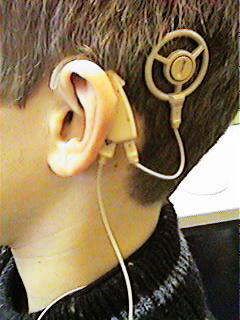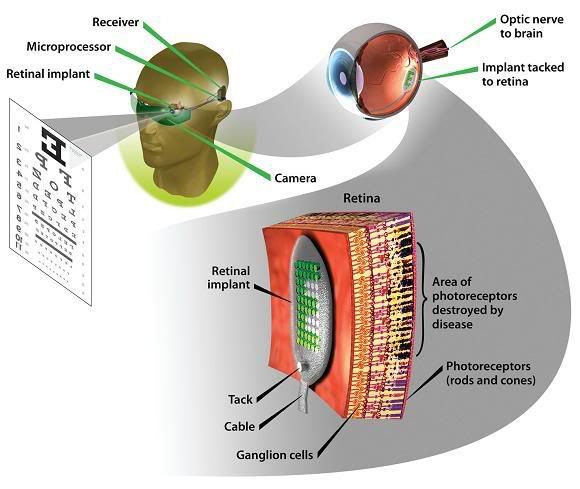
And while bulky and perhaps cosmetically cumbersome, these represent a step in a direction that is really exciting. As our surgical skill and knowledge of anatomy has exponentially increased scientists have made clear that it is possible to literally alter the electromechanics in our brains for a more favorable result. Another such technology is Retinal Implantation. Groups like The Boston Retinal Implant Project are working on a device thinner than the breadth of a hair and equipped with a tiny micro chip that controls small electrical impulses to the retina.

In the two most common types of blindness, retinitis pigmentosa, and age-related macular degeneration, many nerve endings that are in charge of sending visual stimulus to the brain are left in tact, it is these nerves that retinal implants use to simulate natural vision. Again, surgically altering the anatomy to function normally.
Research being conducted by a variety of groups is beginning to successfully control other types of brain function using Neuroengineering techniques. In one such case a group at Standford University led by Dr. Karl Deisseroth created a device that could electronically and wirelessly control the actions of a mouse by stimulating a part of the brain used for motor function. In this video we see the white implant protruding from the mouse's head. When the light is activated his brain is being told to run left. Notice the near perfect left-hand circle the mouse runs for the duration of the lights illumination.
Here again we see the amazing direct control and manipulation of the brain by way of external mechanics. With such technologies it is easy to ask what other parts of the brain could be stimulated or suppressed? Is there a way to surgically alter parts of the brain that control happiness, sadness, or fear? Is it possible to have a similar remote control for our emotions? If all our brain's functions are the process of electrical connections, could we not control every aspect of our brains as we saw fit...technologically overpowering all shortcomings in our brains?
Perhaps we're not there yet, but there are certainly some interesting technologies that indicate the immense potential we have. Transcranial magnetic stimulation or TMS, while not a surgical implantation, is one such technology. Originally used to measure patients' brain function in cranial surgery, TMS has been used recently in some very interesting ways. Researcher Allan Snyder, who works at the Centre for the Mind, who has done a considerable amount of work with autistic savants, is using this shower cap like device to see how it may affect a normal brain. Surprisingly, it may have savant like results. In his few studies he has found "40 percent of the people he exposed to TMS pulses displayed artistic and quantitative abilities that didn't seem to have been present before." Though the affects of the TMS wear off after a short period it opens a broad question of how our brains work, and what potentials we have within us.
As technologies improve, and with them our understanding of our brains, our ability to effectively intervene with failing systems
( ie. brains affected by parkinsons disease, or other degenerative disease) becomes an exciting possibility.
Here Juan Enriquez discusses what such technologies as those used in Neuroengineering could have on our evolution as human beings.
My sources for this little investigation include:
Stuff You Should Know Podcast
How Stuff Works
A two part article on Neuroengineering




No comments:
Post a Comment